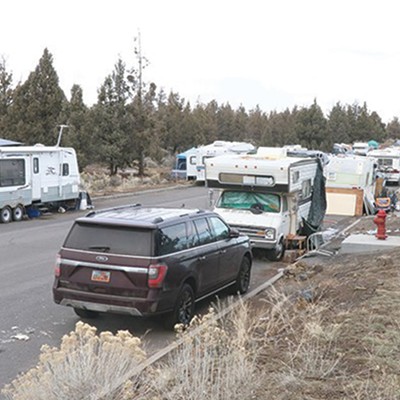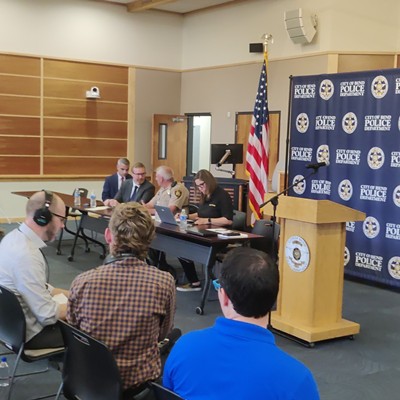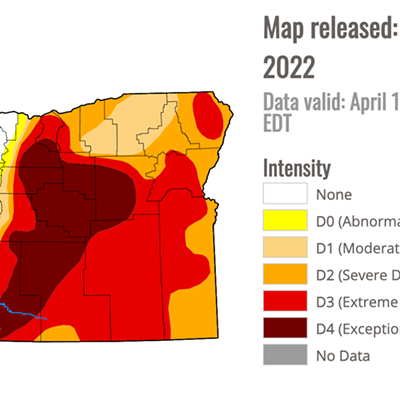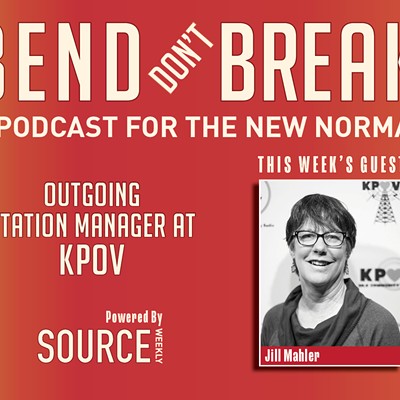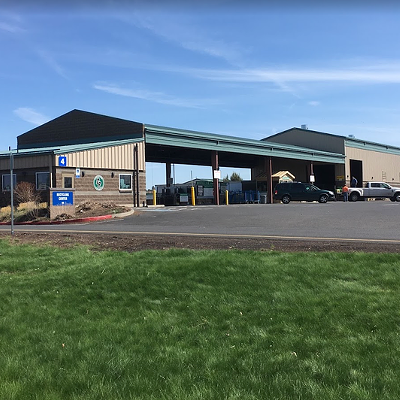It was 2013 when Kim Brannock of Bend first witnessed thousands of dying fish in a side channel of the upper Deschutes River near Lava Island. As co-founder of the Coalition for the Deschutes, she was sickened by the sight, only to find out it had been occurring for decades with seasonal irrigation water flows that run extremely heavy in the summer and light in the winter.
When growers need water, the flow from Wickiup Dam is at its highest level, often causing washed-out channels that damage sensitive riparian environments essential to the health of the river and its fish.
When the growing season is completed by mid-October, the flows are slowed dramatically in order to store water in Crane Prairie and Wickiup reservoirs for the next season. Fish become stranded in side channels with no way to swim to the main stream. The result of this on-and-off water flow is that fish often die. The cycle repeats itself year after year.
For the last four years, in October, a coalition of environmental organizations, fishing groups, government agencies and irrigation officials step into their waders to rescue the fish around Lava Island. Thousands of fish have been rescued. Thousands have died.
"We lost thousands of fish that first year," says Oregon Department of Fish and Wildlife fish biologist Brett Hodgson. Rescue efforts have improved since then, and now most fish trapped in the side channel are successfully transferred to the main river channel. "In all likelihood, this has probably been going on for 50 years since Wickiup was constructed," he says.
The Health of the Deschutes
The rescue effort serves to call attention to the current health of the river and the way it is managed. While the health of the upper Deschutes has been under the microscope for decades since Wickiup Dam was constructed in 1949, there's a growing sense of urgency around finding a more consistent flow of water year-round, so aquatic life can thrive and crops can grow.
For the past three years, rescue efforts have been coordinated by the ODFW. This year the Central Oregon Irrigation District–which must supply water to its 3,600 patrons–is coordinating the rescue. COID's Shon Rae says, "Fish salvage is not a solution to long-standing problems the river is facing." Brannock says the rescue is only a band-aid approach to a much deeper problem of how the river is managed. The Coalition's Gail Snyder adds, "If you wanted to write a manual on how to kill a river, you would do what we've done to the Deschutes."
History records stories of catching thousands of fish for Bend's annual 4th of July celebration fish fry. But that was before the region grew and the demand for water grew with it. "Prior to the construction of Crane Prairie and Wickiup reservoirs, the Deschutes was renowned as being one of the most stable rivers for seasonal flow in the entire world," says Hodgson.
For decades the river thrived on a consistent water flow of between 600-800 cubic feet per second year- round. Since the construction of Wickiup, that flow ranges from 2,000 in the summer to as low as 25-30 cfs in the winter. "It doesn't take a scientist or a fish biologist to figure out that going from 2,000 cfs to 30 is very difficult for fish," says Hodgson. "It's the whole ecology and environment of the upper river that is suffering."
Steeped in Problems
According to Hodgson, the problem goes beyond fish. Macro invertebrates—the base of the food chain that supports all wildlife including fish, frogs and birds—are suffering in the upper Deschutes. Much attention was focused on river health when environmental groups sued over concerns with the threatened spotted frog populations, which are also adversely impacted by inconsistent seasonal water flows. "That's going to have a big influence on how water is managed as well," says Hodgson.
"The problem is well documented, and there are solutions," says Snyder, also a co-founder of the Coalition for the Deschutes, who thinks changes for the river are imminent. She states that the coalition wants to see a return to winter-time flows of 500 cfs at Wickiup in five years. Snyder says she sees a new focus of cooperation by stakeholders who use river water—including the eight irrigation districts that distribute the water—to find solutions. ODFW's Hodgson agrees and says that higher water flows during the winter are the "end game" they are hoping for.
Varying Approaches
While environmentalists and fish biologists agree that there needs to be a higher winter-time water flow, there is some disagreement as to whether or not Central Oregon has enough water to meet all needs.
"The evidence points to there being enough water for farms, fish, and municipalities. The bottom line is that it's going to require sharing the water and using it wisely," says Snyder. But when asked if there is enough water for all, ODFW fish biologist Hodgson was skeptical. "The short answer to that is 'no.' I don't think there is enough water to go around and meet the current demand that is being put on the river right now." Hodgson says there will have to be conservation measures and a reduction in consumptive demand for water in order to make meaningful changes in the river.
Eighty percent of the water in the Deschutes basin is diverted to irrigation districts for agricultural uses. "That's really where the savings have to happen," says Snyder. Both Hodgson and Snyder feel that farming practices will need to become more efficient and water conservation efforts enhanced to meet future demands.
One controversy concerns the condition of irrigation canals in Central Oregon. The Central Oregon Irrigation District has 60 miles of main canals and 400 total miles of canals. COID's Rae says the district has the most potential water gain among districts because there is a 40 percent loss of water in the century-old ditches due to leaks and cracks that allow water to seep into the ground. That loss contributes to the strain on the river, according to Rae.
COID is looking at piping projects to help conserve water, and for many living on canals that is a sore subject. They want to see water, not pipes, running through canals. Local residents are also concerned that irrigation channels are increasingly used for power generation–a purpose for which they were not originally intended.
"Trying to bring the public along is a big challenge," says Rae. "They aren't excited about having their canals piped. But if you look at the big picture, it's unfortunate...but we have some things we're going to have to do that aren't beneficial for some people." It's also costly. According to Rae, the estimated cost of piping the Central Oregon Irrigation District canals is between $400-500 million. At the farm level, the cost of conservation upgrades can be tens of thousands of dollars. Rae suggests that it's hard for farmers to buy in to costly conservation measures if the irrigation districts don't do it first.
Snyder at the Coalition for the Deschutes says the investment is worth every penny. "Long term, the investment we make today in conserving water will pay back many-fold and not just economically but for us as a society for the things that we value and cherish in Central Oregon."
Pat Kliewer of Kliewer Engineering Associates of Bend is a critic of piping and of hydro generation on the canals. In February of this year she told the Source Weekly that hydro projects on the canals contribute to a lack of water in the upper Deschutes. "If we took the power plants offline, would that help conserve water? Absolutely," she said.
In the meantime, a basin study work group is looking at options and answers to help improve the upper Deschutes water flows. The group will issue a report in 2018, but COID's Rae says they should have a good idea of recommendations by the fall of 2017, just one year away. That will include where it makes the most sense to pipe and what financing options are available.
Snyder suggests that piping will be a key conservation component. "Piping the canals and ditches are a crucial part of conserving water that must be done in conjunction with better irrigation practices on the farm." Current practices sometimes include flooding fields rather than using more efficient sprinkler systems.
A Flood of Challenges
ODFW's Hodgson says the irrigation districts—particularly the Central Oregon Irrigation District—have major challenges that they are addressing. "They've got a track record of 50-60 years of doing business a certain way, and now all of a sudden they have people coming at them from different angles telling them you've got to change. I think they realize that change is necessary; it's just taken them awhile to figure out how to implement new measures."
There is a ray of short-term hope. The irrigation districts have agreed that more water can flow from Wickiup dam this winter. In past winters the rate has been slowed to as little as 25 cfs. This winter the flow will be 100 cubic feet per second, providing four times the level of recent winter flows. "That is a great start," says Snyder of the Coalition for the Deschutes.
The goal is that – with updated conservation and management practices—the upper Deschutes River will begin to recover. The long-term hope of the coalition is that the sight of dying fish as witnessed by Brannock won't occur again, and that fish rescues like those conducted over the last four years will become a thing of the past.


